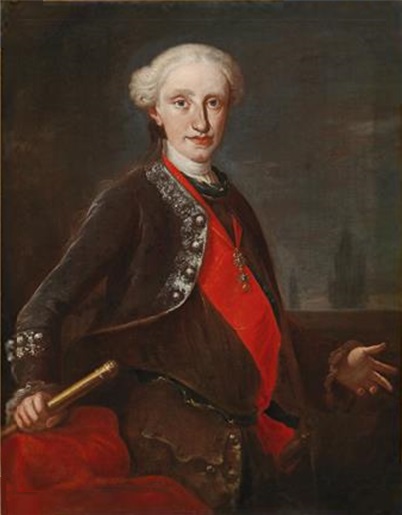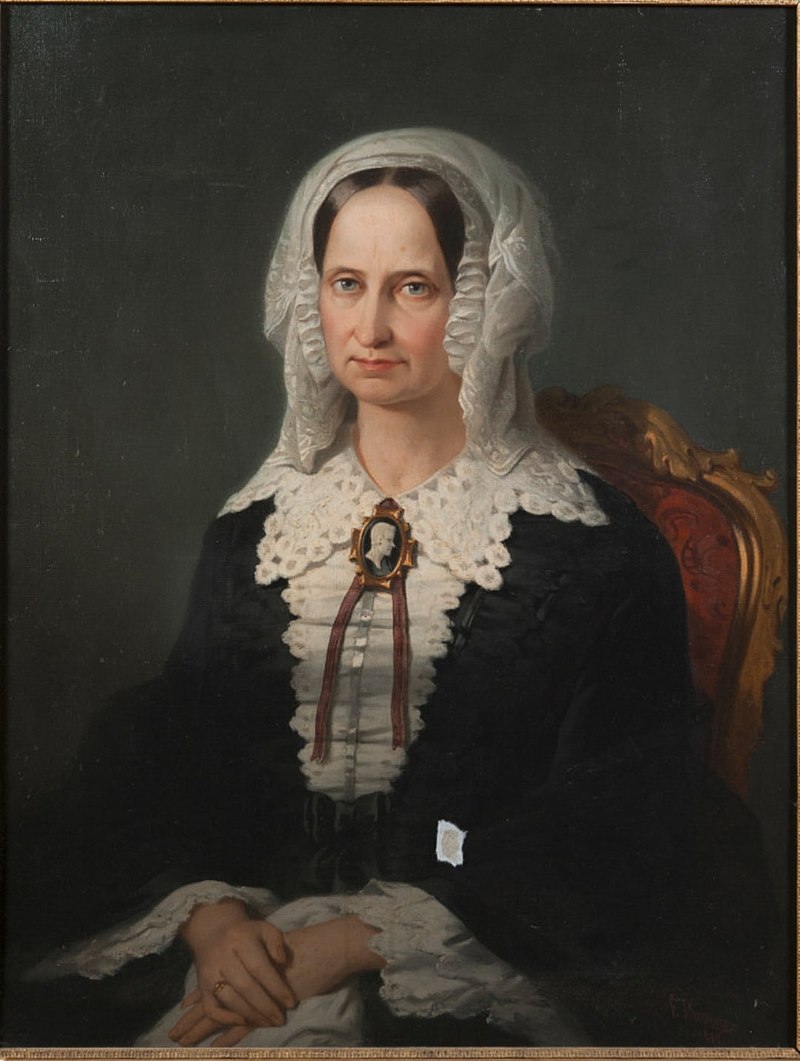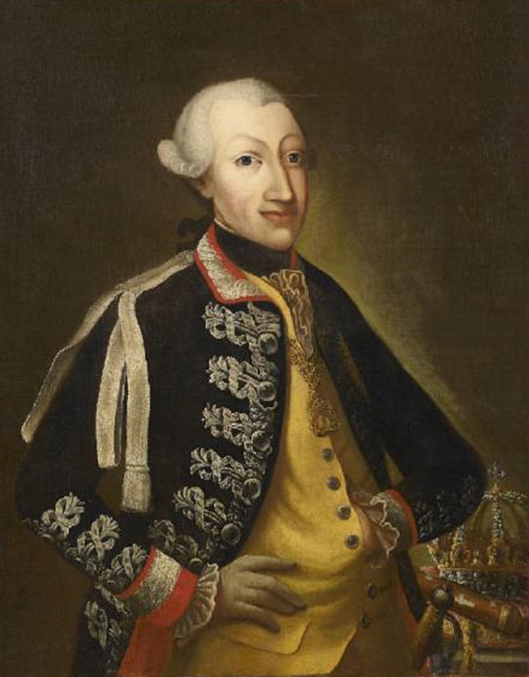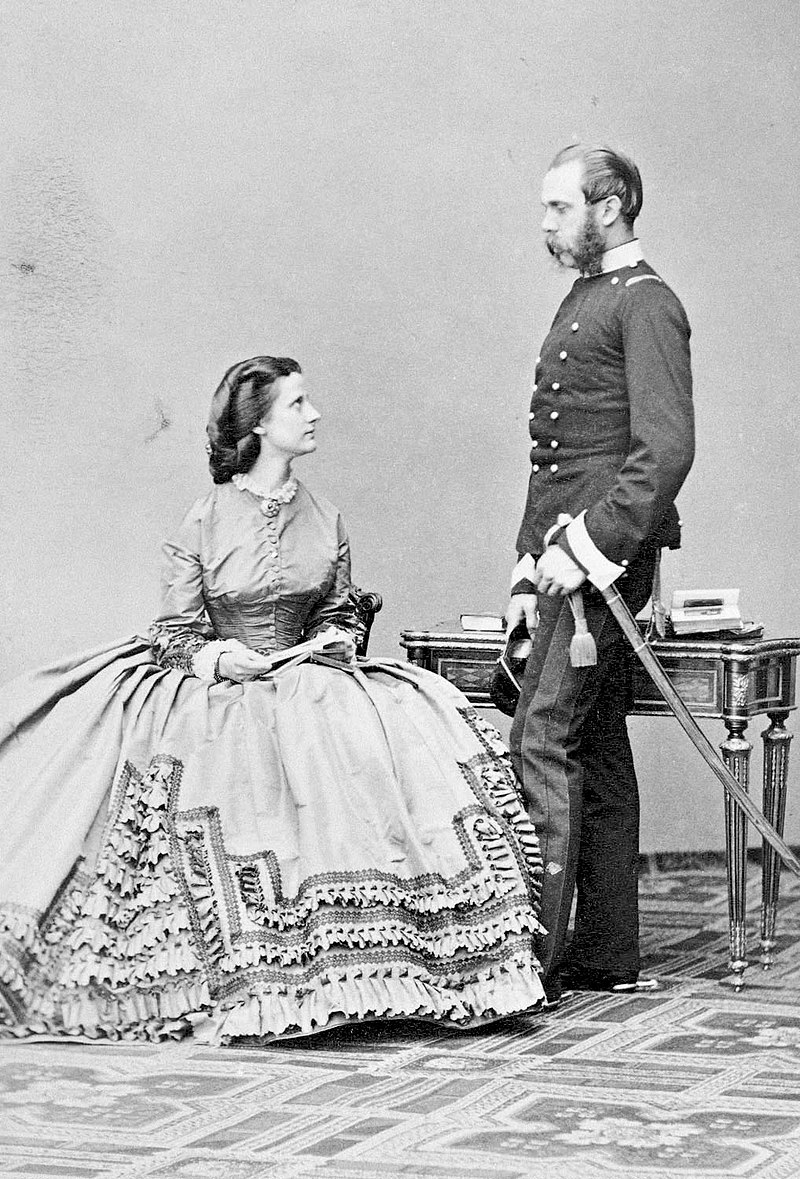by Susan Flantzer
© Unofficial Royalty 2021

Maria Luisa of Spain; Credit – Wikipedia
The Grand Duchy of Tuscany was located in present-day northwest Italy. It existed, with a few interruptions, from 1569 – 1859. Tuscany was ruled by the de Medici family from 1434–1494 and from 1512 until the extinction of its senior branch in 1737. In 1569, Pope Pius V elevated Tuscany to a Grand Duchy and Cosimo I de’ Medici became its first Grand Duke.
In 1737, the House of Habsburg-Lorraine obtained control of the Grand Duchy of Tuscany. François Étienne, Duke of Lorraine exchanged the Duchy of Lorraine for the Grand Duchy of Tuscany. Stanisław I, the father-in-law of King Louis XV of France, had abdicated the throne of Poland in 1736 and now became the Duke of Lorraine.
Except for a period of thirteen years from 1801 – 1814 during the French Revolutionary Wars and Napoleonic Wars, the House of Habsburg-Lorraine retained the Grand Duchy of Tuscany until Tuscany was annexed to the Kingdom of Sardinia in 1860, as a part of the unification of Italy. In 1861, Vittorio Emanuele II, King of Sardinia was proclaimed the first King of the new, united Kingdom of Italy.
Two Grand Dukes of Tuscany were also Holy Roman Emperors: Francesco II Stefano, Grand Duke of Tuscany (reigned 1737 – 1765) also Franz I, Holy Roman Emperor (reigned 1745 – 1765) and Pietro Leopoldo I, Grand Duke of Tuscany (reigned 1765 – 1790) also Leopold II, Holy Roman Emperor (reigned 1790 – 1792).
********************
The Holy Roman Empire was a limited elective monarchy composed of hundreds of kingdoms, principalities, duchies, counties, prince-bishoprics, and Free Imperial Cities in central Europe. The Holy Roman Empire was not really holy since, after Holy Roman Emperor Charles V in 1530, no emperors were crowned by the pope or a bishop. It was not Roman but rather German because it was mainly in the regions of present-day Germany and Austria. It was an empire in name only – the territories it covered were mostly independent each with its own rulers. The Holy Roman Emperor directly ruled over only his family territories, and could not issue decrees and rule autonomously over the Holy Roman Empire. A Holy Roman Emperor was only as strong as his army and alliances, including marriage alliances, made him, and his power was severely restricted by the many sovereigns of the constituent monarchies of the Holy Roman Empire. From the 13th century, prince-electors, or electors for short, elected the Holy Roman Emperor from among the sovereigns of the constituent states.
Frequently but not always, it was common practice to elect the deceased Holy Roman Emperor’s heir. The Holy Roman Empire was an elective monarchy. No person had a legal right to the succession simply because he was related to the current Holy Roman Emperor. However, the Holy Roman Emperor could and often did, while still alive, have a relative (usually a son) elected to succeed him after his death. This elected heir apparent used the title King of the Romans.
Learn more at Unofficial Royalty: What was the Holy Roman Empire?
********************
Infanta Maria Luisa of Spain was Holy Roman Empress, Queen of Hungary and Bohemia, and Grand Duchess of Tuscany as the wife of Leopold II, Holy Roman Emperor/Pietro Leopoldo I, Grand Duke of Tuscany. Born on November 24, 1745, at the Palace of Portici in Naples, Kingdom of Naples, Maria Luisa was the fifth of the thirteen children and the fifth of the seven children of Carlo VII, King of Naples/Carlo IV, King of Sicily (later Carlos III, King of Spain) and Maria Amalia of Saxony. Maria Luisa’s paternal grandparents were Felipe V, King of Spain and his second wife Elisabeth Farnese of Parma. Her maternal grandparents were Augustus III, King of Poland, Grand Duke of Lithuania, and Elector of Saxony and Maria Josepha of Austria.
In 1759, upon the death of his childless half-brother King Ferdinand VI of Spain, Maria Luisa’s father Carlo VII of Naples/Carlo IV of Sicily succeeded him as King Carlos III of Spain. Because of treaties, Carlos could not be the sovereign of all three kingdoms. His eldest son Felipe was excluded from the succession because of mental disability and his second son Carlos was the heir apparent to the Spanish throne. That left the third son Ferdinando to become King of Naples and King of Sicily. Ferdinando was only eight years old when he became King of Naples and Sicily and a regency council ruled until his sixteenth birthday. Fourteen-year-old Maria Luisa and her family, minus her brother Ferdinando, moved to Spain. Maria Luisa and her surviving siblings received the Spanish royal titles Infante or Infanta.

Maria Luisa with her brother Francisco Javier on the left and Carlos on the right; Credit – Wikipedia
Maria Luisa had twelve siblings but six did not survive childhood:
- Princess Maria Isabel of Naples and Sicily (1740 – 1742), died in early childhood
- Princess Maria Josefa of Naples and Sicily (born and died 1742), died in infancy
- Princess Maria Isabel of Naples and Sicily (1743 – 1749), died in childhood.
- Infanta Maria Josefa of Spain (1744 – 1801), unmarried
- Prince Felipe of Spain, Duke of Calabria (1747 – 1777), excluded from succession to the throne due to his mental disability, died from smallpox
- Carlos IV, King of Spain (1748 – 1819), married Princess Maria Luisa of Parma, had fourteen children
- Princess Maria Teresa of Naples and Sicily (1749 – 1750), died in infancy
- Ferdinando I, King of the Two Sicilies (1751 – 1825), married (1) Archduchess Maria Carolina of Austria, had issue (2) Lucia Migliaccio, Duchess of Floridia (morganatic 2nd wife of Ferdinando I, no children
- Infante Gabriel of Spain (1752 – 1788), married Mariana Vitória of Portugal, had three children
- Princess Maria Ana of Naples and Sicily (1754 – 1755), died in infancy
- Infante Antonio Pascual of Spain (1755 – 1817), married his niece Infanta Maria Amalia of Spain who died in childbirth with her son
- Infante Francisco Javier of Spain (1757 – 1771), died in his teens
Maria Luisa was supposed to marry the future Joseph II, Holy Roman Emperor, the eldest son of Empress Maria Theresa, who was in her own right Archduchess of Austria, Queen of Hungary, Queen of Croatia, and Queen of Bohemia and Francis Stephen, Holy Roman Emperor, Grand Duke of Tuscany, and Duke of Lorraine. However, King Louis XV of France disapproved of the match and instead wanted Joseph to marry his granddaughter Isabella of Parma. Not about to give an alliance with Spain, the formidable and powerful Maria Theresa substituted her second surviving son Leopold who was heir to his father’s Grand Duchy of Tuscany.

Maria Luisa’s husband Leopold; Credit – Wikipedia
Maria Luisa and Leopold were married by proxy on February 16, 1764, in Madrid, Spain. 18-year-old Leopold and 20-year-old Maria Luisa were married in person on August 5, 1765, in Innsbruck, Austria. Sadly, just thirteen days later, Leopold’s father Francis Stephen died suddenly in Innsbruck of a stroke or heart attack, at the age of 56, in his carriage while returning from the opera. The eldest son was elected Holy Roman Emperor and reigned as Joseph II. The second (surviving) son and Maria Luisa’s husband Leopold succeeded his father as Pietro Leopoldo I, Grand Duke of Tuscany. The newlyweds settled at the Palazzo Pitti in Florence, the capital of the Grand Duchy of Tuscany, where they would live for the next twenty-five years.

Maria Luisa and Leopold with their children; Credit – Wikipedia
Maria Luisa and Leopold had sixteen children. Because his elder brother Joseph II, Holy Roman Emperor had no children, Leopold became the founder of the main line of the House of Habsburg-Lorraine.
- Archduchess Maria Theresa of Austria (1767 – 1827), married Anton I, King of Saxony, had four children who all died in infancy
- Franz II, Holy Roman Emperor (later Franz I, Emperor of Austria) (1768 – 1835), married (1) Elisabeth of Württemberg, died in childbirth giving birth to a daughter who died in infancy (2) Maria Theresa of Naples and Sicily, had twelve children, died after giving birth to her twelfth child who died three days later (3) Maria Ludovika of Austria-Este, no children, died from tuberculosis (4) Caroline Augusta of Bavaria, no children
- Ferdinando III, Grand Duke of Tuscany (1769 – 1824), married (1) Luisa of Naples and Sicily, had five children, died in giving birth to a stillborn son (2) Maria Ferdinanda of Saxony, no children
- Archduchess Maria Anna of Austria (1770 – 1809), unmarried
- Archduke Karl of Austria (1771 – 1847), married Henrietta of Nassau-Weilburg, had seven children including Maria Theresa who married Ferdinando II, King of the Two Sicilies
- Archduke Alexander Leopold of Austria (1772 – 1795), unmarried, accidentally burned to death from a mishap while conducting a fireworks show
- Archduke Albrecht Johann Joseph of Austria (1773 – 1774), died in infancy
- Archduke Maximilian Johann Joseph of Austria (1774 – 1778), died in childhood
- Archduke Joseph of Austria (1776 – 1847), married (1) Alexandra Pavlovna of Russia, died due to childbirth complications after giving birth to a daughter who died in early childhood (2) Hermine of Anhalt-Bernburg-Schaumburg-Hoym, had children, died in childbirth (3) Maria Dorothea of Württemberg, had five children including Marie-Henriette who married Leopold II, King of the Belgians
- Archduchess Maria Clementina of Austria (1777 – 1801), married Francesco, Duke of Calabria, later King Francesco I of the Two Sicilies, had two children, died from tuberculosis
- Archduke Anton of Austria (1779 – 1835), unmarried
- Archduchess Maria Amalia of Austria (1780 – 1798), unmarried
- Archduke Johann of Austria (1782 – 1859), married morganatically to Countess Anna Plochl, had one son
- Archduke Rainer of Austria (1783 – 1853), married Elisabeth of Savoy, had eight children including Adelaide of Austria who married Vittorio Emanuele II, King of Sardinia, later King of Italy
- Archduke Louis of Austria (1784 – 1864), unmarried
- Archduke Rudolph of Austria, Cardinal-Archbishop of Olomouc (1788 – 1831)
Maria Luisa remained largely unknown to the Tuscan aristocracy and maintained contact with a small group of friends in her private life. She mostly spent her time on the upbringing of her children. As parents, Maria Luisa and Leopold allowed their children a great deal of freedom without being tied to formal court life, and occasionally took them on excursions to rural areas and the coast.
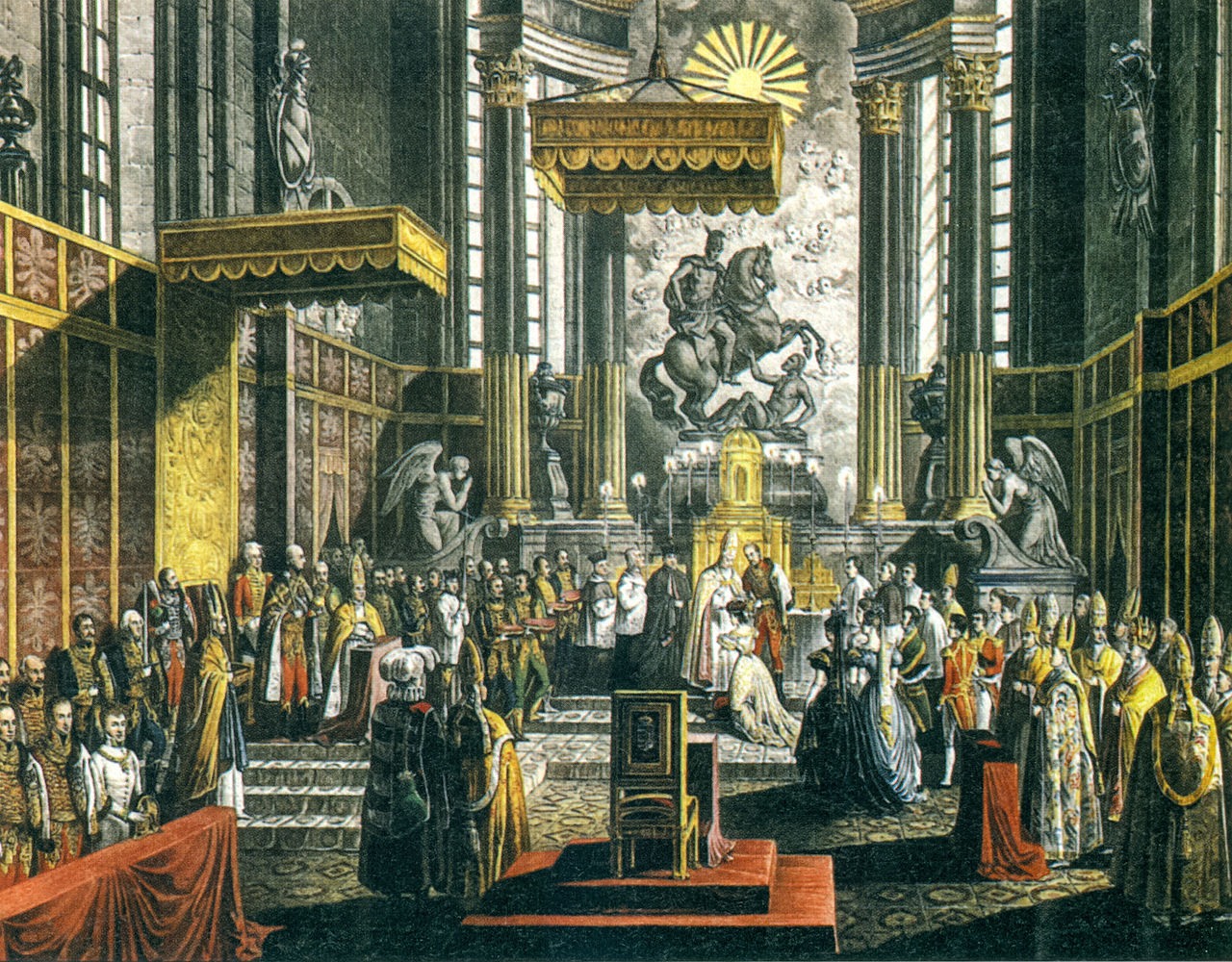
Maria Luisa’s coronation as Queen of Hungary; Credit – Wikipedia
Leopold was elected Holy Roman Emperor in 1790 after the death of his childless brother Joseph. Maria Luisa became Holy Roman Empress, Queen of Hungary, and Queen of Bohemia. At that time, he abdicated the throne of Tuscany in favor of his second son Ferdinand. Leopold, Maria Luisa, and their family moved to Vienna, Austria. After only seventeen months as Holy Roman Emperor, Leopold II died suddenly and unexpectedly on March 1, 1792, aged 44, in Vienna, Austria. He was buried at the Capuchin Church in the Tuscan Crypt of the Imperial Crypt in Vienna, Austria. Leopold’s eldest son Franz was elected (the last) Holy Roman Emperor and later was the first Emperor of Austria.
Maria Luisa’s tomb in the Imperial Crypt; Credit – Wikipedia
Less than three months after the sudden death of her husband, Maria Luisa also died suddenly, aged 46, on May 15, 1792, at Hofburg Palace in Vienna, Austria. She was buried next to her husband at the Capuchin Church in the Tuscan Crypt at the Imperial Crypt in Vienna, Austria. Their early deaths left their nine youngest children, all under the age of 18, orphans.
Grand Duchy of Tuscany Resources at Unofficial Royalty
This article is the intellectual property of Unofficial Royalty and is NOT TO BE COPIED, EDITED, OR POSTED IN ANY FORM ON ANOTHER WEBSITE under any circumstances. It is permissible to use a link that directs to Unofficial Royalty.
Works Cited
- En.wikipedia.org. 2021. Maria Luisa of Spain – Wikipedia. [online] Available at: <https://en.wikipedia.org/wiki/Maria_Luisa_of_Spain> [Accessed 23 September 2021].
- Flantzer, Susan, 2021. Leopold II, Holy Roman Emperor, Pietro Leopoldo I, Grand Duke of Tuscany. [online] Unofficial Royalty. Available at: <https://www.unofficialroyalty.com/leopold-ii-holy-roman-emperor-pietro-leopoldo-i-grand-duke-of-tuscany/> [Accessed 23 September 2021].
- Flantzer, Susan, 2013. Maria Theresa, Archduchess of Austria, and Queen of Hungary, Croatia, and Bohemia. [online] Unofficial Royalty. Available at: <https://www.unofficialroyalty.com/maria-theresa-archduchess-of-austria-queen-of-hungary-croatia-and-bohemia/> [Accessed 19 September 2021].
- It.wikipedia.org. 2021. Maria Luisa di Borbone-Spagna (1745-1792) – Wikipedia. [online] Available at: <https://it.wikipedia.org/wiki/Maria_Luisa_di_Borbone-Spagna_(1745-1792)> [Accessed 23 September 2021].
- Wilson, Peter, 2016. Heart of Europe – A History of the Holy Roman Empire. Cambridge: Belknap Press of Harvard University Press.



























